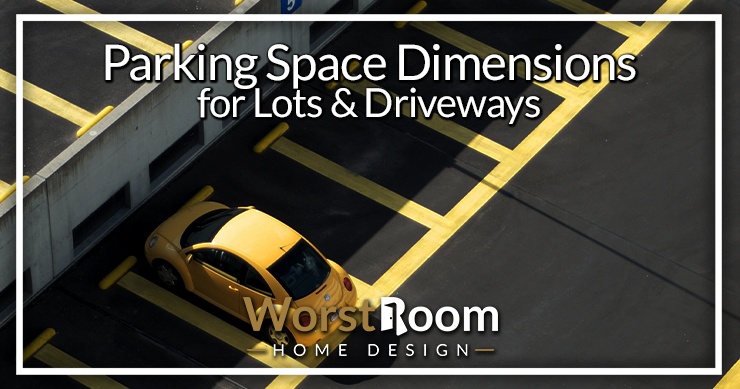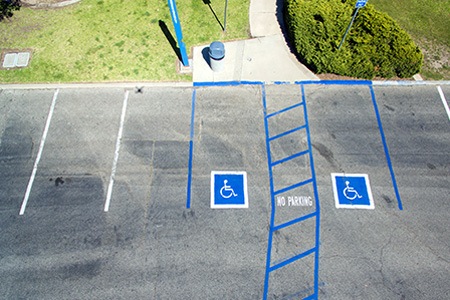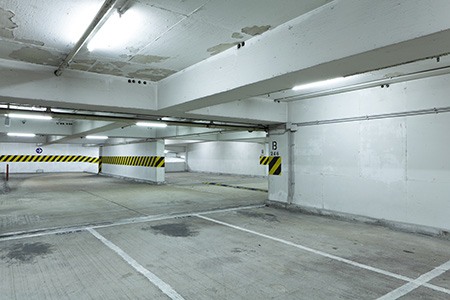Parking Space Dimensions for Lots & Driveways
Author: Rick Worst | Editor: Omar Alonso
Review & Research: Jen Worst & Chris Miller

Unless you're in charge of designing parking lots or are about to lay a driveway, you probably haven't given much thought to parking space dimensions. While parking spaces tend to be roughly the same throughout the country, there are cases where they'll be smaller or larger than the standard size.
So whether you're trying to configure a parking lot layout or are just curious, here's everything you need to know about the dimensions of standard parking spaces.
General Standard Parking Space Dimensions
While there are a lot of varying dimensions for parking spaces, in the United States, there's a general standard for parking spaces. Most parking spaces will be between 7 and 9 feet wide and 16 to 20 feet long.
Regarding parallel parking spaces, they tend to be the same width, but they'll be 20 to 24 feet long. So, the standard width parking space is 7 to 9 feet, but the length of a parking space often varies, especially depending on the angle of the parking space, which we discuss below.
Parking Space Dimensions Considerations
To the average person, there might not be a lot to think about when considering parking stall dimensions. That said, there are actually a lot of things to think about dimension-wise and something that can affect the size of a parking spot. There are plenty of options available to you, all as long as you don't block the driveway with the spots.
Parking Space Angles

There are a few different parking space angles that you might want to think about. Even though most people go for a 90-degree angle, the others might work better for some parking lots.
Straight
Straight parking spaces at the most common ones you'll see. They're the regular straight ones in parking lots, but parallel parking spots also fall under this category. Straight parking spaces are seven to nine feet wide and 16 to 20 feet long. You should keep this is mind for any types of driveways you may be parking in, as well.
Parallel parking spaces will have about a four feet buffer to allow for easier access to the space when parking.
30-Degrees
One-way roads can benefit from 30-degree parking spaces. The parking format will be 44 feet across in total. Each parking space will be about 16 feet long, allowing 12 feet of driving space between the stalls.
This parking setup is excellent for maneuverability because drivers barely need to turn their cars to get out of the parking lot. With these parking spaces, all doors will be easy to open and get in and out of.
45-Degrees
Something people appreciate about 45-degree parking spaces because they can fit more cars in one area. They're tight angles and are commonly seen on one-way roads or parking lots.
Drivers will need to be extra careful in these lots because of the one-way nature. They'll need to drive slower. Depending on how many spaces are in the lot, some people might find it challenging to get in and out of their vehicle since they're close together.
60-Degrees
60-degree angles might be the best option for broader parking spaces. They have about 20 feet of driving between each parking space.
They allow a lot more room for moving around and are easier to back into. When there's parking on both sides, the dimensions tend to be 18 feet wide and 21 feet long.
90-Degrees
90-degree parking spaces are the most efficient in most cases. Depending on the shape of the parking lot, you'll be able to fit more parking spaces if they're all 90 degrees than with other angles. That's why they're often a part of the standard parking space size specs when efficiently using up a parking lot.
The one unfortunate thing about 90-degree parking spaces is that they're not the best when it comes to being ADA-compliant. They're not nearly as ADA-compliant because parking spaces are very close together, which can make getting in and out tricky for people with accessibility problems.
The Size of the Parking Lot

It might seem obvious that the size of the parking lot will ultimately determine how many parking spaces and the dimensions of the parking spaces you can have. The layout will help determine which size of parking spaces you can include and the way to include the most parking lots possible.
For high-traffic areas like department and grocery stores, perpendicular parking spaces tend to be the most common. However, there are some cases where these parking lots are too big for the amount of traffic they see, so they can use larger parking spaces to take up more room.
Certain parking lots will want to take advantage of specialty vehicle parking, which can limit the number of standard parking spaces you can include. Therefore, it's essential to know the size of the parking lot, and then you can play around with different configurations to find the best parking space options for that particular parking lot.
Drainage
In a perfect world, every parking lot would have a natural slope to allow for drainage. The good news is that most parking lots aren't entirely flat anyway, nor are any driveway alternatives. Every parking lot needs a slight slope to help with drainage when it rains or snows.
When installing drainage points, you'll want to ensure they're away from the entrance to the buildings so that pedestrians and moving vehicles aren't nearly as affected. The last thing you want is for the parking lot to flood thanks to improper drainage.
ADA-Compliant Parking Spaces
Every parking lot must have at least one ADA-compliant parking spot. However, how many of these spaces you add can affect the dimensions of other parking spaces in the lot. Sometimes, these spots can make it nearly impossible to fill the rest of the spots evenly.
Van-accessible ADA parking spots need to be eight to 11 feet wide and have an access aisle five feet wide next to it. Depending on where the parking lot is going, there might be requirements on how many ADA-compliant parking spaces there needs to be. For example, hospitals and medical offices need more than a department store.
Specialty Parking Space Dimensions

While we might be able to nail down a size of a typical parking space for the average vehicle, there are other types of vehicles we must concern ourselves with. These can include buses, motorcycles, and oversized vans.
Besides parking lots for standard vehicles, there are a few specialty parking spaces you might need to think about adding to the parking lot. Here's a quick look at those and what their typical dimensions are.
Buses
Buses will take up plenty of space, and the typical parking space dimensions they need are 14 feet wide and either 40 to 60 long. Most parking lots don't need dedicated bus parking spaces, but larger locations will, like schools, arenas, and larger companies.
Semi-Trucks
Semi-trucks take up far more space than other vehicles, so adding semi-truck parking lots will take up much more room. But, mostly, these vehicles need a parking space that's 30 feet wide and 15 feet long, at least.
These dimensions are without a trailer, so anything more extensive will need a longer space. Companies with trucks that have trailers will need another 53 feet on the parking space to park there safely.
Motorcycle

For the most part, many parking lots just allow motorcycles to park in regular parking spots. However, if there's an interest in adding a motorcycle parking space or stall, they have different dimensions because they are typically smaller than cars.
Motorcycle parking spaces tend to be four feet wide and nine feet long. Traditional parking spaces can fit several motorcycles, but having individual motorcycle stalls can be beneficial if motorcyclists are popular in a particular parking lot.
Lighting
Lighting is necessary for a parking lot so people and vehicles can safely move around. The good news is that lighting typically has a low impact on the parking lot layout overall.
Most parking lot lights range in height from 12 to 35 feet and can vary in brightness and coverage levels. Depending on where the parking lot is going, they might have to abide by different regulations, like government buildings need to meet FEMP standards.
Either way, the size and number of lights you choose to put in the parking lot can affect the dimensions of each parking space and how many you can include in the total.
Pedestrians
When constructing a parking lot, you must consider how low or high the pedestrian activity is. Pedestrian traffic can heavily impact the best parking space dimensions, so you must consider it beforehand.
You'll want to think about how to safely allow pedestrians through the parking lot while maximizing the number of parking spaces you want to be able to provide.
Frequently Asked Questions Regarding Parking Spaces

Do you still have questions about parking space dimensions? Then, look at some frequently asked questions about parking spaces below for more information.
How Many Square Feet Is in a 200 Parking Space Lot?
It's hard to know the exact number, but it's estimated to be 65,000 square feet based on each stall needing 325 square feet.
How Many Standard Cars Can Park in 1,000 Square Feet?
Based on standard calculations, roughly five cars should be able to park in 1,000 square feet of space comfortably.
How Do I Stop My Neighbors From Parking in Front of My House?
There are many ways to approach the problem of a neighbor constantly parking in front of your house, some of which you should avoid and many you should pursue before involving anyone who has authority over the two of you, such as a homeowner's association or a landlord. Your first attempt should be speaking with the neighbor calmly and respectfully.
Standard Parking Space Dimensions Still Vary Some
When you factor in specialty parking spaces, you'll see a massive difference in the dimensions. No matter how many parking spaces and which kind you're adding, make sure you leave plenty of room for vehicles, safe paths for pedestrians, and that you're ADA compliant.
For the most part, parking space dimensions are the same everywhere. There are a few different angles to choose from, which can change the dimensions slightly, but overall, most parking spaces are seven to nine feet wide and 16 to 20 feet long.



